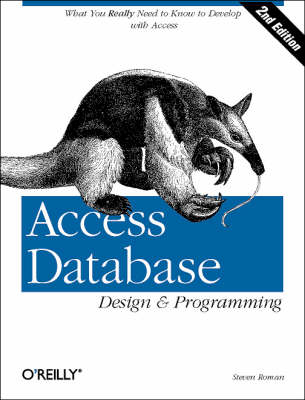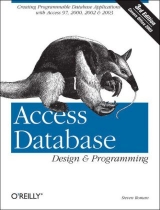
Access Database Design & Programming
O'Reilly Media (Verlag)
978-1-56592-626-4 (ISBN)
- Titel ist leider vergriffen;
keine Neuauflage - Artikel merken
When using software products with graphical interfaces, we frequently focus so much on the details of how to use the interface that we forget about the more general concepts that allow us to understand and put the software to effective use. This is particularly true of a powerful database product like Microsoft Access. Novice, and sometimes even experienced, programmers are so concerned with how something is done in Access that they often lose sight of the general principles that underlie their database applications. This text, an update to the bestselling first edition, features: a discussion of Access' new VBA Integrated Development Environment, which is the one used by Word, Excel, and PowerPoint; an expansion of the discussion of the VBA language itself, in response to reader requests; a discussion of Microsoft's latest data access technology, called Active Data Objects (or ADO), along with a discussion of Open Database; and Connectivity (ODBC), which is intimately connected with ADO. The book focuses on the core concepts, enabling programmers to develop solid, effective database applications.
As a result, important topics such as designing forms and reports, database security, database replication, and programming for multiuser applications are simply not discussed. This book is a kind of "second course" in Access that provides a relatively experienced Access user who is new to programming with the frequently overlooked techniques necessary to successfully develop in the Microsoft Access environment. Although this book is really an introduction targeted at intermediate Microsoft Access users who are novice programmers, it should appeal to all levels of Access developers. For novice programmers, it focuses on a key body of knowledge that is typically neglected, but is nevertheless essential for developing effective database applications. For intermediate and advanced developers, its treatment of database design and queries provides a handy treatment that otherwise has to be gleaned from relatively uninteresting textbooks, while its programming chapters constitute a handy reference to some basic operations that can be performed using DAO or the Access object model.
Steven Roman is a Professor Emeritus of mathematics at the California State University, Fullerton. He has taught at a number of other universities, including MIT, the University of California at Santa Barbara, and the University of South Florida. Dr. Roman received his B.A. degree from the University of California at Los Angeles and his Ph.D. from the University of Washington. Dr. Roman has authored 32 books, including a number of books on mathematics, such as Coding and Information Theory, Advanced Linear Algebra, and Field Theory, published by Springer-Verlag. He has also written a series of 15 small books entitled Modules in Mathematics, designed for the general college-level liberal arts student. Beside his books for O'Reilly (Access Database Design & Programming, Learning Word Programming, Writing Excel Macros, Developing Visual Basic Add-ins, Win32 API Programming with Visual Basic (in production), Dr. Roman has written two other computer books, entitled Concepts of Object-Oriented Programming with Visual Basic and Understanding Personal Computer Hardware, an in-depth look at how PC hardware works, both published by Springer-Verlag. Dr. Roman is interested in combinatorics, algebra, and computer science.
Preface I. Database Design 1. Introduction Database Design Database Programming 2. The Entity-Relationship Model of a Database What Is a Database? Entities and Their Attributes Keys and Superkeys Relationships Between Entities 3. Relational Databases 19 Implementing Entities A Short Glossary Implementing the Relationships in a Relational Database The LIBRARY Relational Database Index Files NULL Values 4. Database Design Principles Redundancy Normal Forms First Normal Form Functional Dependencies Second Normal Form Third Normal Form Boyce-Codd Normal Form Normalization II. Database Queries 5. Query Languages and the Relational Algebra Query Languages Relational Algebra and Relational Calculus Details of the Relational Algebra 6. Access Structured Query Language (SQL) Introduction to Access SQL Access Query Design Access Query Types Why Use SQL? Access SQL The DDL Component of Access SQL The DML Component of Access SQL III. Database Architecture 7. Database System Architecture Why Program? Database Systems Database Management Systems The Jet DBMS Data Definition Languages Data Manipulation Languages Host Languages The Client/Server Architecture IV. Visual Basic for Applications 8. The Visual Basic Editor, Part I The Project Window The Properties Window The Code Window The Immediate Window Arranging Windows 9. The Visual Basic Editor, Part II Navigating the IDE Getting Help Creating a Procedure Run Time, Design Time, and Break Mode Errors Debugging 10. Variables, Data Types, and Constants Comments Line Continuation Constants Variables and Data Types VBA Operators 11. Functions and Subroutines Calling Functions Calling Subroutines Parameters and Arguments Exiting a Procedure Public and Private Procedures Fully Qualified Procedure Names 12. Built-in Functions and Statements The MsgBox Function The InputBox Function VBA String Functions Miscellaneous Functions and Statements Handling Errors in Code 13. Control Statements The If-Then Statement The For Loop Exit For The For Each Loop The Do Loop The Select Case Statement A Final Note on VBA V. Data Access Objects 14. Programming DAO: Overview Objects The DAO Object Model The Microsoft Access Object Model Referencing Objects Collections Are Objects Too The Properties Collection Closing DAO Objects A Look at the DAO Objects The CurrentDb Function 15. Programming DAO: Data Definition Language Creating a Database Opening a Database Creating a Table and Its Fields Creating an Index Creating a Relation Creating a QueryDef 16. Programming DAO: Data Manipulation Language Recordset Objects Opening a Recordset Moving Through a Recordset Finding Records in a Recordset Editing Data Using a Recordset VI. ActiveX Data Objects 17. ADO and OLE DB What Is ADO? Installing ADO ADO and OLE DB The ADO Object Model Finding OLE DB Providers A Closer Look at Connection Strings VII. Appendixes A. DAO 3.0/3.5 Collections, Properties, and Methods B. of the Relational Algebra 362 C. Open Database Connectivity (ODBC) D. Obtaining or Creating the Sample Database E. Suggestions for Further Reading
| Erscheint lt. Verlag | 13.8.1999 |
|---|---|
| Zusatzinfo | illustrations |
| Verlagsort | Sebastopol |
| Sprache | englisch |
| Maße | 178 x 232 mm |
| Gewicht | 690 g |
| Einbandart | kartoniert |
| Themenwelt | Mathematik / Informatik ► Informatik ► Datenbanken |
| Informatik ► Office Programme ► Access | |
| Mathematik / Informatik ► Informatik ► Programmiersprachen / -werkzeuge | |
| ISBN-10 | 1-56592-626-9 / 1565926269 |
| ISBN-13 | 978-1-56592-626-4 / 9781565926264 |
| Zustand | Neuware |
| Haben Sie eine Frage zum Produkt? |
aus dem Bereich



